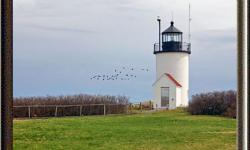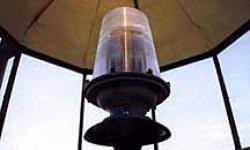Cape Porpoise, United States was named by Capt. John Smith for a school of porpoises he saw there. Established in August 1833 for $6,000, Goat Island Light was established to help guide mariners into the sheltered harbor at Cape Porpoise, a busy fishing center for many years. A 20-foot stone tower and dwelling were built, and John Lord of Kennebunk became the first keeper at a salary of $350 per year.
In 1859, the tower and house were rebuilt. The new tower received a fifth-order Fresnel lens. For many years, the tower was connected to the 1 1/2-story house by a covered walkway. A boathouse was added in 1905 and an oil house in 1907.
Dangerous rocks near Goat Island continued to claim vessels, including 46 between 1865 and 1920. There was not one death in all the wrecks, partly due to the keepers at Goat Island picking up survivors near the island. In 1930, a schooner, the Margery Austin, went aground near the Lighthouse.
Keeper James M. Anderson went out in rough seas and helped refloat the vessel.
George Wakefield of Saco kept the light from 1887 to 1921, the longest stint of any keeper at the station. Wakefield moonlighted as a harbor pilot and fisherman.
Coast Guard Keeper Joseph Bakken, who lived on Goat Island with his wife and three children, told historian Edward Rowe Snow about his experience during a particularly severe storm in 1947. The waves washed over the island and damaged the walkway and the boat slip and ripped out a fence. In the commotion the family forgot about their dog and her newborn puppies.
Later that night, Bakken went into the cellar and found several feet of water. Floating in the seawater was the box that contained the dog and her puppies. All were safe and sound and the keeper brought them upstairs out of harm's way.
U.S. Coast Guard photo The Coast Guard initially planned to automate Goat Island Light in 1976. Local residents felt that having a keeper on Goat Island was important to protect the island and Lighthouse station from vandalism, so the automation plans were postponed.
In 1990, Goat Island Light became the last Lighthouse in Maine to be automated. Its Fresnel lens was replaced by a modern 300mm optic. Brad Culp, his wife Lisa and their two children Christian and Dakota were Maine's last traditional Lighthouse family. Lisa Culp said of her eight-year old son Christian, "I think it's something he'll carry with him all his life."
For a time during the presidency of George H. W. Bush, secret service agents lived at Goat Island Light, which offers a good vantage point on Bush's estate at Walker's Point. The island served as an air-sea command center complete with a radar beacon.


Goat Island Light reviews
Login to comment